About Our Costumes — an Interview with Steven Tenney
Janet Mervin (janet@polarisproductions.org) has designed costumes for The Boy Friend, Annie, Little Shop of Horrors, A Christmas Carol, and Bye Bye Birdie — costumes that evoked period and character with precision and subtlety while bearing the unmistakable edge of style and elegance. They have managed to be beautiful, extraordinarily inventive, and all on a shoestring budget. They have transported actors and audiences alike to different worlds. I took it up with LeCee Johnson, the director and producer of these remarkable shows…
LeCee: Janet’s process is more right brain than left. She works from an unconscious place tempered with an exquisite sense of design and extensive training. Was her training in costume design? I know she studied millinery, but the larger part of her skill comes from her background in fashion and her innate affinity for design. We walk down the street and she notices outfits or the way a window is dressed. I am aware that she has a highly cultivated sense of design. The love of harmony and a sense of beauty is something that brings Janet Mervin, Carol Cote and I together. What puts them ahead of the crowd is divinely-inspired craftsmanship.
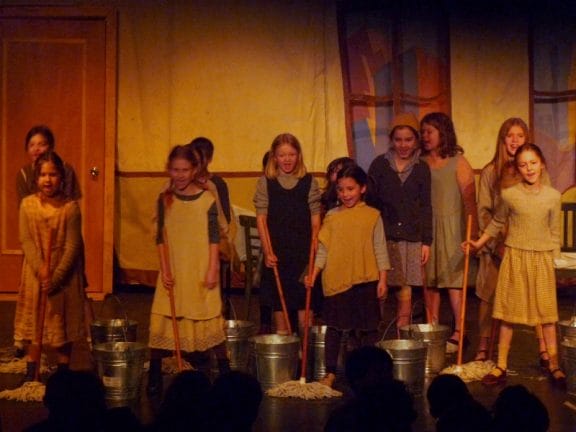
—— The crisp servant outfits Janet made for Annie… pitch perfect in look, fitted with sartorial splendor. I knew what sort of home Daddy Warbucks’ mansion was. They contrasted perfectly with Carol’s exquisite orphan dresses.
LeCee: Remember that Annie had three Hannigans? Each of those had a costume individual to that performer. Each girl was a different size and had a different take on the role; hence, each girl had a different costume. And the costumes aren’t just slapped together. Janet thought about each girl and what would work for her interpretation of the role.
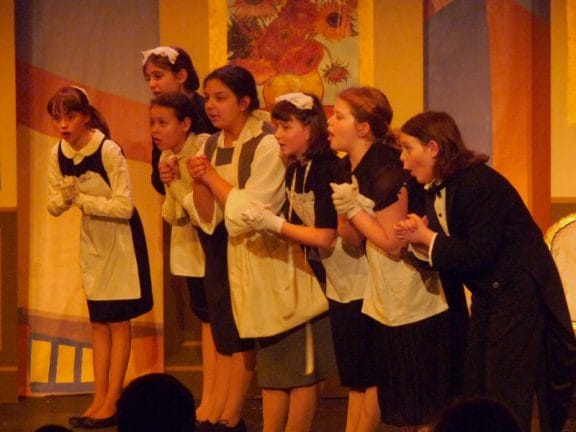
—— How does it all happen? How do you manage to get such results?
LeCee: I remember watching Janet at work at the Theater Development Fund costume department, looking for pieces for Christmas Carol. We’d walk down the aisles and Janet would say, “That could work. We’ll put that aside.” She did that, with different people for weeks and then reevaluated everything. When she didn’t find everything she needed, she created “faux period” costumes, putting items together. I couldn’t tell the difference. Janet chooses a color palette for each scene. The audience doesn’t necessarily think about that, but the harmony within scenes is reassuring and resonates deeply. Janet and I consult and then she takes over. The rest of us follow suit, doing whatever needs to be done. Mostly, I stay out of the way.
—— The first show where you were deeply involved with costumes was The Boy Friend…
LeCee: Janet, Elaine Bevington and I worked closely on The Boy Friend. Elaine went to Pennsylvania for items because prices were better. I found $3.24 dresses from Target that Janet turned into gorgeous 1920s costumes with fabric Elaine found in thrift and fabric stores.
—— Carol mentioned how magical that transformation was.
LeCee: I found straw visor caps that Janet turned into cloches that matched the dress it was paired with. I’d take a picture of an item with my phone and Janet and I would discuss it. Janet saves things. I’m a tosser and appreciate savers. Doing costumes is a huge growth for me. I was kicked off the costume committee in college when I sewed two left legs onto Vic Gallerano’s costume. I’ve great admiration for Janet and Carol —producing incredible, well-executed designs. These support the show’s vision and give actors a hook into their role. With young actors, this is essential.
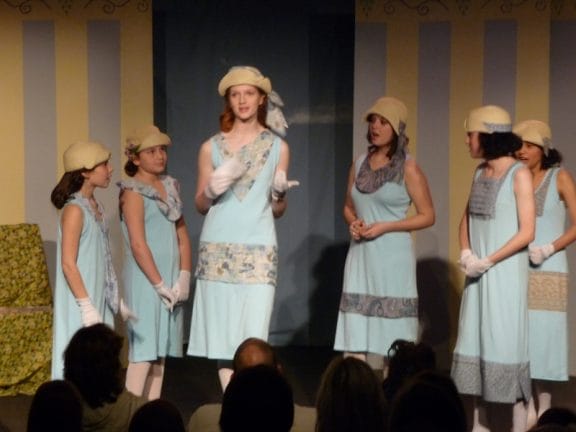
—— Carol, I recall the array of orphans’ costumes you did for Annie, arrayed on racks in your loft. They were dramatic images of shabby circumstance, evoking the Great Depression instantly. Yet their artful distressing, their chromatic progressions, were gorgeous!
Carol: Janet’s sense of color is exquisite, artistic and spot on. As to the period issue, I’m sure Janet will have some thoughts. In A Christmas Carol great creativity was needed due to the few costumes available that fit the kids and were somewhat of the proper era. Janet availed herself of her considerable creativity for creating costumes that “felt“ period but were made of pieced together somewhat current clothing. I dubbed it “faux period”, which amused both of us.
—— You were kind enough to show me an email you sent your Dad. Would you mind sharing it?
Carol: I wrote… “Here are a few photos I took from our production of A Christmas Carol. The costume I made is the one in dark green, kind of Father Christmas-y looking. My friend Janet, who did all the other costumes [some rentals tossed in] had started a green cape for her son. I reworked it and added the fur collar [which was mine from when I was a kid] and made the head wreath and staff. What was fun was how it came together. Two weeks ago I found the fabric for the robe in the garbage next door [they have upholstery companies in the building and there were a few bolts of gorgeous fabrics that caught my eye… of course I had to rescue them]. I also used a foam “rubber stamp” and printed the border at the bottom and along the edge of the sleeves. You may recognize the trim used as his belt from something Mom bought years ago in Switzerland. The gold ribbon on the staff is from my wedding bouquet. The beautiful white iridescent over garment worn by Ghost of Christmas past was from Paris. Janet bought it for herself years ago when she was a high fashion model in Paris. This show is all about transformation and how we incorporate the past into our present. It is fun to think that this is what took place with the costumes as well.”
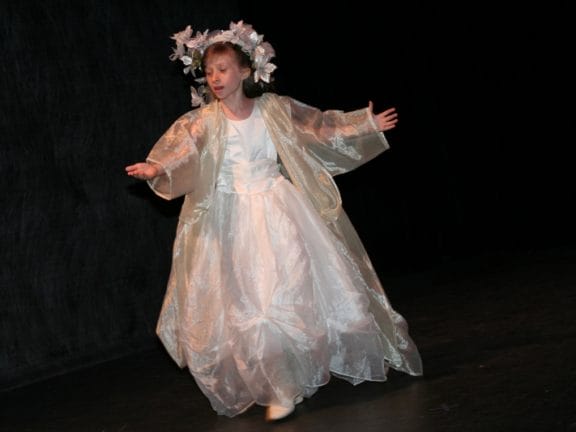
—— The sophistication in all this is astonishing. Janet, material for so many costumes must be exhausting to acquire! Not just Little Shop of Horrors, but little horrors of shopping.
Janet: For Annie, I remember going to Queens, coming home with bags of clothing on the subway. I got stuck dragging more than I could carry in torrential rains. I was sopping wet but the finds were fabulous. Ben’s Warbucks suit was an Ungaro, perfect but too expensive. I kept going back until their spring sale. Luckily it was still there.
—— Speaking of Little Shop, what a challenge the Plant must have been. It was a tour-de-force!
Janet: I really loved the idea of Georgia [who played the Plant] being on stage. From the beginning, Yves and I had the fairy bed in mind from Midsummer as the plant base. My coat came to mind, which I dug out of the closet, and pieces started falling into place. I found the purple dress from Into the Woods amongst the costumes and it matched. I sewed ivy vines up the front of the coat and made a matching head wreath, put on after the plant grew. Then, in the spirit of the fairy bed, I made petals around the opening of the laundry bag from Annie so the plant would have a mouth. I love it when things come together, a bit of this, some of that, and it all ties together. I love reusing things. Blair picked up some grad dresses from free cycle for Annie which didn’t end up fitting in, but for Little Shop one of the dresses looked like it was made for the show. There was a flower on it that resembled our Plant, color-wise and shape. The dress was white, perfect for Audrey when she offers herself to the plant. I love those small details. They tie everything together.
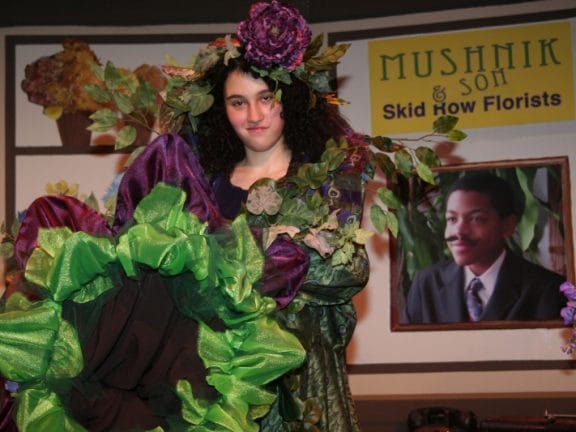
—— You hemmed, unhemmed, and rehemmed the same plaid trousers for the two Seymours after every show. The sheer technical execution dizzies me. But I’m intrigued by your creative process. Can you elaborate?
Janet: After going through the script and running over scenes with LeCee, I usually start by going through my closet and the children’s. I keep costumes from show to show and rethink how they can fit in again. Going through thrift stores can be very time consuming but rewarding. I start very slowly and speed up as I go along when things start taking shape. When things click I work on those and wait for the stagnant sections to start flowing. Eventually ideas all start fitting together and take shape. Watching rehearsals helps, getting to know the different characters and the actors playing them affects costume decisions.
—— You’ve spoken of getting things without knowing yet why you needed them. It’s a lovely image of the unconscious at work in art.
Janet: For A Christmas Carol part of the costuming was a different experience. Using a costume rental wasn’t as easy as I first thought, too many choices and few of the children could wear adult sizes. But it was such a great resource and helped create the period with the boy’s jackets and hats, a few hoops and big skirts and boots.
Sometimes things are just being in the right place, asking the right questions. One day Korrina Cragnotti stopped by to pick something up and I asked where she was off to. She told me about the sale at TDF Costume Rentals and said she could bring a guest. So I grabbed my coat. There was the Ghost of Christmas Future’s robe and hood, all ready and waiting, not to mention a couple of Collecting Men suits and old Joe’s coat! Fabulous costumes for next to nothing. Still, this was only a quarter of the costumes. Finding big skirts and coordinating colors was proving impossible. Then people came with a piece here, a piece there, and things started matching up. The Fezziwig Dance scene was a lot of fun and some trouble creating the period. I kept recombining pieces as other pieces appeared. This part reminded me of working with Carol on the orphans. She had gathered so many great pieces and as the children tried them on they were remixed and remixed and all came out so beautifully. I had friends, Carol Cote, Leslie Burby, Irene Stern, come in and give fresh eyes, pieces, and ideas. The actors were very gracious, trying on many costumes, including those that weren’t theirs, to see what worked best for whom.
—— Forgive the interruption. I’ve never seen any actor look less than fabulous in what you’ve designed.
Janet: Finally, in the Fezziwig Dance scene, I was down to one costume missing. One week before tech and I was still searching. I went to visit a friend in Woodstock where there are some very good thrift stores. I found a couple of pieces that my intuition made me pick up, though I couldn’t see how they fit. Then I spotted a skirt and jacket on the last day, but it wasn’t priced and they wouldn’t sell it. So I went back twice. At the end of the next day (I stayed an extra night) I bought it and it worked perfectly with the first two pieces I had picked up. Whew, the last costume for the Ball, in the nick of time! I resized the skirt and cut up the sash to make a big ruffle on the bottom of it and realized it would work very well with a blouse that Carol had offered. In the end this costume was one of my favorites, next to Leigh’s Ghost of Christmas Past and Carol’s Ghost of Christmas Present. Ghost of Christmas Past was the first costume to have all its pieces together. When I first thought of Christmas Past my transparent coat came to mind. There was a white dress from Honk with black flowers and a sash that were removed. Then both pieces were taken up in the front so Leigh could turn and not trip. The bridal veil from Midsummer was trimmed with white and silver poinsettias and leaves and mini lights from my sons’ supplies. The boots were from the rentals which really finished the look and helped anchor it in time.
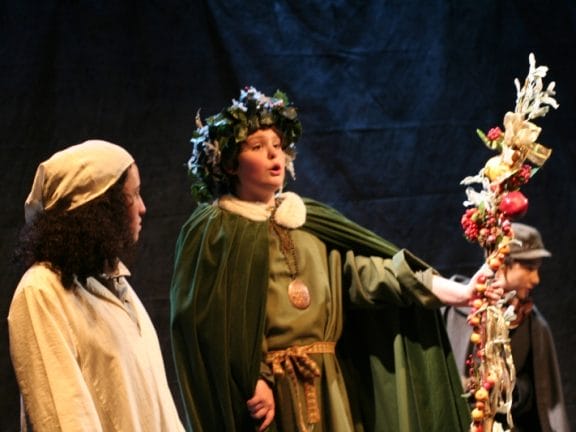
Sometimes things just happen, as in Sarah’s dress for Belle, which almost didn’t happen, but then as she was leaving TDF I found a dress tucked away that had been missed. It was perfect and green. Gabriel had mentioned he would like a green jacket for Dick Wilkins, if he had a choice, which usually you don’t, but as it turned out this worked beautifully since in the story though Belle loves Ebenezer she ends up marrying Dick. So having them matching foreshadows the future.
One of the funniest stories from A Christmas Carol was Jeffrey’s hat, which was much too small. I didn’t have time to exchange it and Tony Smethurst joked I should just make one. I looked at him and said, “Yes, absolutely, why didn’t I think of that!” Tony didn’t know I had studied millinery and had supplies at home to do it. I had a brown felt cone that I blocked on a pot. It wasn’t the best hat ever, but it worked on stage and fit Bob Crachit’s character.
—— How central these costumes were! They telegraphed character with flair — the Ghost of Christmas Past crowned with electric lights — and freed the production from elaborate sets. Scenes within scenes, ghostly visitations, were evoked gracefully with scrims and minimalist staging. Things slid together like a translucent puzzle box. LeCee, Into the Woods was your first show. I understand all costumes inherited from NYCHEA Players were destroyed by fungus and had to be discarded. “Into the woods” in more ways than one! Where did it all begin?”
LeCee: We started from scratch. In thrift stores. It’s because we’re supporting our kids that we have the drive to do the work. The magic ingredient, however, is the imagination and skill our parent base brings to these productions.
—— And I know an untold number have contributed. There’s something about parents making costumes for kids. Maybe it’s the recollection of my mom and dad making Halloween costumes. Those memories move through fantasy like a ghost crowned with electric lights. …And next?
LeCee: Bye Bye Birdie.
—— One of my favorite musicals! I still remember the production I saw in high school. Will the costumes transport everyone nonstop to the late 50s?
LeCee: We’re playing the show 1958-1959, when Elvis was drafted into the army. In Sweet Apple, Ohio, they’re not au courant, the feel is more mid 50s. Janet and I talked about this.
— Steven Tenney
(Steven Tenney has for many years taught math in both the home-schooled and schooled communities. In his spare time, he writes plays himself.)
[The preceding article appeared in the April 2012 edition of the NYCHEA Newsletter under the title, “Ghost Crowned with Electric Lights”.]
[Bye Bye Birdie was performed at The Hudson Guild Theater, 441 West 26th St., May 10th through May 13th. ]